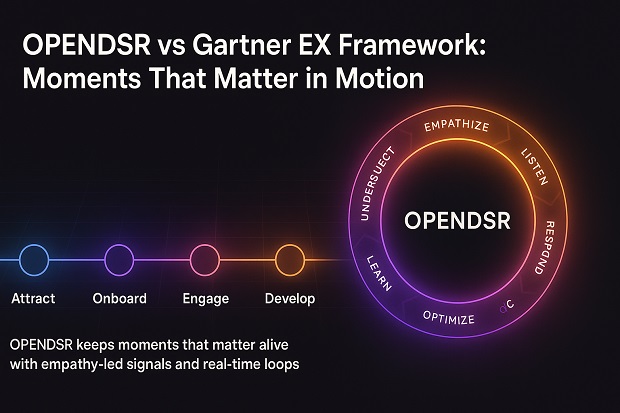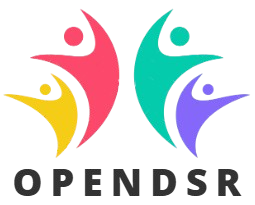
Gartner Framework vs OPENDSR: Moments That Matter in Motion
Gartner Framework vs OPENDSR: Moments That Matter in Motion How OPENDSR transforms Gartner’s “Moments That Matter” into living, empathetic, and continuously improving experiences. 1. Introduction: Beyond the Moment—Designing Motion
In the age of hybrid work, employee experience (EX) is no longer a one-time design project. It’s a living system that breathes, learns, and evolves with every interaction, every change, every emotion.
Gartner’s Employee Experience Framework, particularly its focus on Moments That Matter (MTM), changed the way leaders think about engagement. It shifted EX from broad surveys and policies to pinpointed touchpoints that deeply affect how employees feel about their organizations — from onboarding and performance reviews to recognition, transitions, and exits.
Yet, as organizations embrace real-time work models, even “moments” are not enough. What matters now is motion — the continuous sensing, feedback, and adaptation around these moments.
That’s where OPENDSR (Observe, Prioritize, Envision, Navigate, Design, Systematize, Refine) comes in — turning static touchpoints into empathy-led, data-informed, and continuously optimized experiences.
In essence:
Gartner defines the moments that matter. OPENDSR keeps them alive.
2. Revisiting Gartner’s Employee Experience FrameworkGartner’s EX Framework is built on three major tenets:
-
Moments That Matter (MTM):
Specific points in the employee journey that disproportionately impact perception and engagement — e.g., first day, promotion, feedback, personal milestone. -
Experience Drivers:
Enablers like clarity, empathy, manager effectiveness, and organizational support that shape these moments. -
Experience Outcomes:
Engagement, trust, intent to stay, and advocacy — the cumulative results of well-managed moments.
Great EX is not about managing every interaction — it’s about mastering the few that truly matter.
This insight helped HR leaders shift focus from processes to perceptions. But in practice, organizations still struggle with three things:
-
Timeliness — detecting when a moment is happening
-
Relevance — knowing which moments matter for which employees
-
Actionability — responding quickly with empathy and precision
These challenges are where OPENDSR’s real-time intelligence and design system approach delivers exponential value.
3. Introducing OPENDSR: From Moments to MotionOPENDSR redefines how organizations design, measure, and evolve employee experiences by combining behavioral science with data systems.
It operationalizes empathy and improvement through a seven-step cycle that ensures every moment — whether it’s onboarding or burnout recovery — is sensed, prioritized, designed, and refined continuously.
Step Action Impact on Employee Experience Observe Continuously sense signals and feedback from employees and workflows. Detect emerging moments early. Prioritize Identify which experiences or personas need attention first. Focus on what truly matters now. Envision Co-create the ideal experience with employees. Embed empathy and inclusion in design. Navigate Map paths and interventions for improvement. Ensure alignment and pacing of change. Design Prototype, test, and validate experience improvements. Transform insights into tangible actions. Systematize Scale successful experiences across teams. Create consistency and reliability. Refine Measure and adjust continuously. Keep EX relevant, alive, and responsive.OPENDSR complements Gartner’s framework by infusing it with motion intelligence — ensuring moments are not just designed, but dynamically lived.
4. Comparative Overview: Gartner vs OPENDSR Dimension Gartner’s EX Framework OPENDSR Framework Core Shift Focus Designing “moments that matter” Sustaining “motion that evolves” From static milestones → dynamic evolution Design Basis Human perception and behavioral insight Human-centered design and data intelligence Adds real-time empathy to perception Measurement Periodic feedback (e.g., pulse or survey) Continuous sensing and signal loops From reflection → live adaptation Scope Defined touchpoints End-to-end system of experiences Expands scope from events to environments Outcome Engagement and retention Trust, flow, and adaptive well-being Broader human outcome spectrumSummary Insight:
While Gartner’s model pinpoints what matters, OPENDSR enables how it continuously matters.
To understand the evolution, let’s look at the conceptual distinction between the two paradigms.
Attribute Gartner’s Moments That Matter OPENDSR’s Moments in Motion Definition Key points that shape employee perception. Continuous states of experience evolving through feedback. Example “Manager 1:1 feedback conversation.” “Continuous coaching relationship measured and improved in real time.” Data Source Survey or feedback after the event. Multimodal signals (sentiment, workflow data, feedback, collaboration). Leadership Role Recognize and act on moments. Sense, co-design, and iterate in motion. Technology Role Capture and visualize engagement data. Interpret, predict, and guide human experience.The shift is subtle but profound.
Gartner focuses on recognition of significance, while OPENDSR ensures sustained significance through empathy and motion.
Gartner’s EX playbook identifies “moments that matter” and encourages organizations to design them well.
OPENDSR adds a dynamic layer — each moment becomes a loop, with signals feeding back into design and refinement.
Gartner advocates empathy as a leadership trait; OPENDSR treats empathy as a measurable system capability.
Metric Type Gartner’s Use OPENDSR Enhancement Sentiment Surveys Measure feelings post-event Measure live emotional state through pulse signals Engagement Index Static scoring model Adaptive EX index evolving per feedback loop Manager Impact Leadership empathy measured annually Leadership micro-behaviors tracked and improved weeklyThis real-time empathy loop transforms managers from “moment facilitators” to “experience designers.”
7. The Data Philosophy: From Surveys to SignalsTraditional Gartner-based models depend on structured feedback — surveys, engagement scores, and focus groups.
OPENDSR broadens this lens through signal intelligence — subtle, behavioral, and contextual indicators from across the EX spectrum.
By interpreting multiple signal types, OPENDSR transforms “feedback” into continuous EX telemetry — helping organizations see change as it happens, not after it’s too late.
8. Case Example: Keeping Moments Alive Scenario: Global Financial Services Firm-
Challenge:
Employees cited frustration during promotion cycles — unclear communication, perceived bias, delayed recognition.
Traditional surveys showed the issue, but by the time results arrived, sentiment had already turned sour. -
With OPENDSR:
Through continuous observation (Observe), live feedback on recognition and fairness was collected.
Real-time Navigate and Design phases helped HR refine communication tone and manager coaching.
Within one quarter, perceived fairness scores rose by 31%, and attrition risk fell by 18%.
The true power lies not in replacement but in augmentation.
Gartner’s “Moments That Matter” remain the map — OPENDSR becomes the GPS.
In this sense, OPENDSR doesn’t just track moments — it animates them.
10. The Human-Centered AdvantageWhat distinguishes OPENDSR most profoundly is its human design ethos.
Human Lens Gartner OPENDSR Empathy Leadership-driven System-enabled Personalization Persona-level Individual-level Belonging Programmatic Lived and sensed dynamically Feedback After-action Continuous micro-feedback Evolution Reactive Proactive and predictiveThis human-centered loop ensures that employees don’t just “have moments that matter” — they experience a flow of care, clarity, and co-creation that defines belonging.
11. Comparative Table: Gartner Framework vs OPENDSR Aspect Gartner’s Moments That Matter OPENDSR’s Moments in Motion Intent Identify touchpoints that shape experience Keep experience evolving through empathy-led design Temporal Nature Event-based Continuous and adaptive Measurement Cycle Periodic Real-time System Type Conceptual Framework Operational Model Data Input Surveys and interviews Multi-signal sensing (behavioral + emotional) Outcome Improved engagement Sustained trust and flow Leadership Mindset Manage touchpoints Co-design experience ecosystem 12. Philosophical Reflection: From Empathy as Emotion to Empathy as InfrastructureIn Gartner’s era, empathy was understood as a leader’s soft skill — the ability to listen and respond thoughtfully.
In OPENDSR’s world, empathy is infrastructure — designed into systems, dashboards, and daily decisions.
It’s not just about caring once in a while — it’s about embedding care into the operating model.
Through its 7-step cycle, OPENDSR ensures empathy becomes repeatable, measurable, and scalable — the cornerstone of a living, breathing organization.
13. Future Outlook: Experience Operating SystemsGartner’s framework opened the door for experience-centric HR.
OPENDSR walks through that door and builds the architecture inside — connecting data, design, and emotion.
In the next decade, we will see:
-
EX Operating Systems replacing fragmented HR tools
-
AI-driven empathy loops guiding leadership behaviors
-
Predictive EX analytics surfacing moments before they occur
-
Human-centered governance balancing automation with authenticity
And at the heart of all this: OPENDSR as the live engine, keeping moments in motion.
14. Conclusion: Keeping the Pulse AliveThe difference between Gartner’s and OPENDSR’s models mirrors the evolution of work itself — from episodic to continuous, from managerial to experiential, from analytical to human.
-
Gartner gave us the why — the understanding that certain moments define our experience.
-
OPENDSR gives us the how — the capability to sense, design, and refine those experiences in real time.
As organizations mature in EX intelligence, they must move from measuring the moments that matter to sustaining the motion that transforms.
Because the future of work isn’t a series of moments — it’s a flow of meaning.
In summary:
Gartner defines the map of moments.
OPENDSR animates the journey.
Together, they transform the employee experience from static insight to living intelligence — one moment, one motion, one human at a time.








